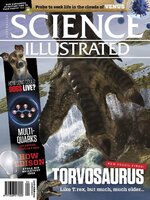Science Illustrated delivers natural science, break through discoveries and an understanding of the world for the entire family. Packed with stunning photography and in-depth editorial it’s a visually spectacular gateway to the world looking into the beginning of life to distant objects in the universe.
SUBSCRIBE & START SAVING NOW!
Science Illustrated
MEGAPIXEL // JUPITER’S RINGS
Black hole on the run • A supermassive black hole is speeding out of its home galaxy, leaving a star-strewn trail longer than the Milky Way is wide.
Dinosaur sounded like a crocodile-bird • Ankylosaurus fossils indicate that the prehistoric creature may have expressed itself in ways other than just roaring like a movie dinosaur.
Unpopular plane seats are the safest • Analyses of 35 years of accidents tell you which plane seats to pick.
The world’s deadliest fungus can switch how it reproduces • In the genetic information of the death cap, scientists may have found the reason why this toxic mushroom is so efficiently spreading in several regions of the world.
Shared houses also share bacteria • People living together often share many things. One of them turns out to be bacteria, as a large study into bacterial transfer reveals how co-habitants can affect your health.
Ancient runes found in Norway • Archaeologists have discovered enigmatic characters and patterns on an ancient runic stone.
Is Earth’s core changing the way it rotates? • We cannot examine Earth’s core directly, but seismic waves from earthquakes over the past six decades may allow scientists to identify changes down in the depths.
Dogs’ tails not used for balance • For many animals, the tail is an important tool for movement. But not so much for dogs, according to a new study which suggests other uses.
What is mRNA? • Since the COVID-19 vaccine was introduced, we’ve been hearing about mRNA and its role in Pfizer and Moderna jabs. But what is it?
How well can elephants smell? • “Does the long trunk of an elephant give it an advantage for a sense of smell? Or is it more designed as a tool for other things?”
Why do allergies cause itching? • “I suffer from allergies, and I understand what causes them. But what’s the process that makes my eyes and skin itch so much? And why?”
Why are there no green mammals? • There are green amphibians and reptiles, the colour providing useful camouflage. So why are there no green mammals?
…trees disappeared? • “I heard that Australia has lost some 50% of our forests and bushlands since European settlement. What would happen if all the trees on Earth were to disappear?”
How green is solar-cell manufacturing? • Solar power is one of the renewable energy solutions that can help us reduce our use of fossil fuels. But how climate-friendly and environmentally-friendly is their whole-of-life footprint?
To what extent is passive smoking a health risk for non-smokers? • Your neighbours smoke on their balcony, or you have a smoking grandparent living in a house with a child. What are the risks?
WHERE IS THIS? · Sawn Rocks, north-western NSW • Australia contains some of the world’s oldest rocks, and some unique rock formations. Sawn Rocks is near Narrabri in NSW.
…cracking my fingers can give me arthritis? • ‘I have an aunt who tells me I’ll get arthritis if I keep cracking my finger joints. Is she right? What happens?’
A FAMILY TREE FOR OUR SUN • The first stars that lit up after the Big Bang burned out long ago, but their remains are still alive. Astronomers now think they have discovered one of the very oldest stars. So how does the ancient giant fit into the Sun’s family tree?
Bright black hole reveals the ancient star • Astronomers are uncertain that direct...

 Issue 111
Issue 111
 Issue 110
Issue 110
 Issue 109
Issue 109
 Issue 108
Issue 108
 Issue 107
Issue 107
 Issue 106
Issue 106
 Issue 105
Issue 105
 Issue 104
Issue 104
 Issue 103
Issue 103
 Issue 102
Issue 102
 Issue 101
Issue 101
 Issue 100
Issue 100
 Issue 99
Issue 99
 Issue 98
Issue 98
 Issue 97
Issue 97
 Issue 96
Issue 96
 Issue 95
Issue 95
 Issue 94
Issue 94
 Issue 93
Issue 93
 Issue 92
Issue 92
 Issue 91
Issue 91
 Issue 90
Issue 90
 Issue 89
Issue 89
 Issue 88
Issue 88
